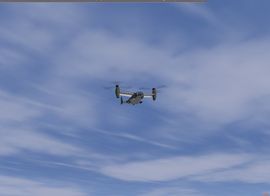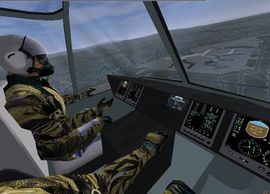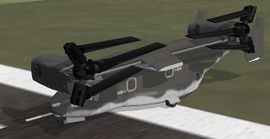Bell Boeing V-22 Osprey
 | |
|---|---|
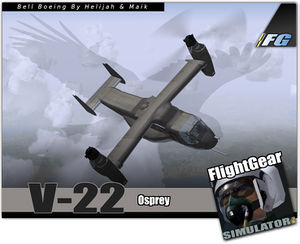 | |
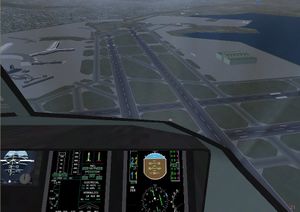 The cockpit of the V-22. Note descent rate. | |
| Type | Tiltrotor aircraft, Helicopter, VTOL aircraft, STOL aircraft, Military transport aircraft |
| Configuration | High wing aircraft |
| Propulsion | Turboshaft aircraft, Twin-engine aircraft |
| Manufacturer | Bell, Boeing |
| Author(s) |
|
| FDM | YASim |
| --aircraft= | v22 |
| Status | Beta |
| FDM |
|
| Systems |
|
| Cockpit |
|
| Model |
|
| Development | |
| Hangar |
|
| Website |
|
| Repository |
|
| Download |
|
| License | GPLv2+ |
|
| |
The V22 Osprey is not a plane, nor a helicopter: it is a tiltrotor aircraft, so it's both!
Summary
The V-22 Osprey is an interesting aircraft, and the FlightGear model is a fully functional, instrumented model that is relatively easy to fly.
First Flight
The first thing to do is to start the engines by pressing and holding down the } key. The rotors take a while to start. The rotors slowly increase in speed until they become a blur.
The simplest take- off is a vertical one. Make sure the controls are absolutely centered before starting otherwise the aircraft will roll and crash into the tarmac. Increase the rotor pitch by pressing the "Page Down" key. Yes, that's right, "Page Down". For some reason, page up decreases the pitch of the blades or the power. Press the "Page Down" key and watch the aircraft climb vertically into the sky.
Once you are up to a good height, say 2,000 ft, slowly test the controls. The left stick makes the aircraft roll to the left but starts yaw as well probably due to the airflow hitting the tail surfaces, which means that now you are spinning like a top at 2,000 ft and going nowhere. To stop the spinning, use opposite stick, that is, stick to the right. Rudder controls will work as well, I suppose but I did not try them.
On my second flight, once again I had to correct rotation to the left using right aileron, very gently, to get the V-22 pointing in one direction. A little forward speed was gained by tilting the rotor forward, progressively. At this point, a strong pitch up was encountered, and after a struggle, the level flight was restored. The rotors were tilted progressively forwards, and the aircraft gained speed without losing height. Pitch changes were easily controlled this time.
With the rotors at a full-forward tilt, the V-22 behaved like a fixed-wing aircraft, although ailerons were a bit slow to respond, stable turns could be made.
On the first flight, the landing was easier than I thought, from a vertical hover, the spinning stopped, I lowered power until a comfortable 2,000 ft per minute descent was indicated on the lower right instrument. A slight forward velocity was also experienced, which I left without checking. At the last moment, I increased power and slowed descent to 200 fpm and landed solidly.
The descent is the most stable and pleasant part of the flight for me. The V-22 will fly hands-off in a descent, almost. I established a 2,000 fpm descent and descended all the way down to the ground, landing on a roadway at about 40kt forward speed and about 2,000 fpm, which is slightly excessive. 400 fpm is the maximum that would be comfortable, I would think. Once I have the 'collective pitch' figured out this should be easy.
I would prefer if left and right stick resulted in roll only, with automatic compensation for yaw, however this probably a design feature to make it fly like a helicopter.
After two flights, this is definitely an aircraft I want to fly again, with its fascinating VTOL capability, impressive looks, attractive digital cockpit, and decent handling. One could really go places in this one.
All in all, a fascinating aircraft, nicely modeled, with an excellent cockpit. This one brings out all that is best in FlightGear.
Compatibility
- FlightGear 1.9.1.: Loads and runs
- FlightGear 2.0: Not Tested
- FlightGear 2.4: Not Tested
- FlightGear 2.6: Not Tested
- FlightGear 2017.1.3: Loads and runs
Aircraft help
| Key | Function |
|---|---|
| } | Start engines |
| { | Stop engines |
| PageUp | Increase power |
| PageDown | Decrease power |
| m | Tilt rotors forward by 10 degrees |
| M | Tilt rotors afterward by 10 degrees |
| Alt+M | Tilt rotors vertical |
| n | Unfold wing |
| N | Fold wing |
- The tilt range is -10deg .. 0deg (vertical) .. 90deg (horizontal)
- The allowed tilt range is a function of the aircraft's speed.
- The flight computer limits the actual tilt to this range.
- Therefore you can lift off with vertical rotors and accelerate like a helicopter.
- The computer will increase the tilt with increasing airspeed.
- For faster acceleration set the tilt to the maximum.
- The Osprey can hover within a range of -10deg to 30deg.
- You can set the tilt to horizontal/90deg on the ground. Due to the lack of speed, the tilt is limited to 30deg max.
External Links
| ||||||||
| |||||||||||
